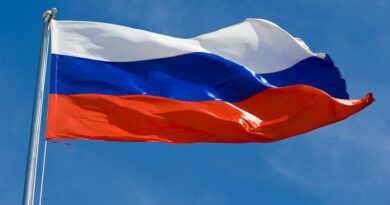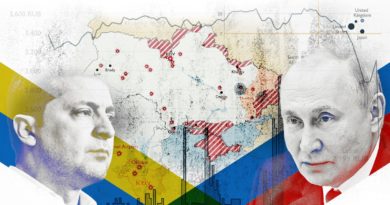The Biggest International Whodunnit? CIA Leak Points At Ukrainian Hand For Nord Stream Pipeline Attack
The European countries have been saying it for a long, but it had been in hushed tones for want of evidence. However, a recent report by the Washington Post has revealed that the United States had prior intelligence from a European intelligence agency that the Ukrainian saboteurs intended to blow up the Nord Stream natural gas pipeline, the double-string undersea gas link traversing 1,200 kilometers through Russian, Finnish, Swedish, Danish and German territorial waters.
China Begins Development Of World’s ‘Most Powerful’ Warship Radar That Can Track Multiple Targets Upto Guam
What was earlier a suspicion is now becoming apparent that the attack against the Russian-owned pipelines that were weakening the resolve of Germany and other European countries to stand up against Russia was deliberate. The report has vindicated the stand of those who called out the theories of Russia bombing its pipeline.
The report says that the Biden administration had learned three months before the bombing that the Ukrainian military planned to attack the undersea network with the help of a small team of divers, taking orders directly from the Ukrainian Army Chief Valery Saluschnyj.
The intelligence report from a European Union intelligence service was detailed to the extent of the number of operatives and methods of attack; and provides one of the direct pieces of evidence linking the Ukrainian government with the saboteur act against Europe’s energy infrastructure.
The Post has withheld the name of the European country and some aspects of the suspected plan at the request of government officials, citing risks to sources and operations.
The CIA got privy to the intelligence in June 2022 and shared it with Germany and other European countries Last June. The European intelligence report was shared on the chat platform Discord, allegedly by National Guard member Jack Teixeira.
Ukraine denied any responsibility for the attacks, with the top adviser to Zelensky referring to the idea as an “amusing conspiracy” theory.
The Russian Embassy lost no time pointing out the Western countries’ “coordinated” deception in light of the new evidence. “The coordinated campaign of the West, led by the United States, to confuse the international community is sewn with white threads,” Russian diplomat Andrey Ledenev said in a post on the embassy’s Telegram messaging channel.
The European countries have been carrying out their investigation into the bombing. The German agencies uncovered similarities between the bombing and the attack planned by Kyiv.
The German investigators recently raided a home in connection with the explosions that rendered the Nord Stream defunct. The German media has reported that the investigators have found the yacht Andromeda, which divers could have used to reach the Nord Stream pipelines or as a decoy.
Seven months after Russia invaded Ukraine, a slew of underwater explosions on September 26 caused massive leaks on Nord Stream 1 and 2 pipelines, leaving only one of the four gas links intact.
The blasts, in Danish and Swedish waters, were picked up by seismic monitors before coast guards saw leaked gas bubbling to the surface of the Baltic Sea. In the aftermath of the incident, President Joe Biden blamed Russia for the “deliberate act of sabotage.”
Neither pipeline was functioning at the time of the explosions after Russian exporter Gazprom cut off gas through Nord Stream 1 in August. German Chancellor Olaf Scholz suspended the Nord Stream 2 project shortly before Russia’s invasion, with the pipeline never going into operation.
German Probe Into The Sabotage
The German public prosecutors had discovered the links between the sabotage and Ukraine. At the beginning of 2023, the German investigators were quoted by the German media saying the team which placed the explosive charges on the pipelines was comprised of five men — a captain, two divers, and two diving assistants — as well as one woman doctor, all of them of unknown nationality and operating with false passports.
The report said they left the German port of Rostock on September 6 on the rented boat.

It added that the yacht was later returned to the owner “in uncleaned condition” and that “on the table in the cabin, the investigators were able to detect traces of explosives.”
The definite lead confirming Ukraine’s hand in the sabotage puts its ties with Germany in a precarious position. A bit hesitant at first, Germany emerged as one of the biggest suppliers of military aid to the war-ravaged country. The German establishment was yet to comment on the new revelations at the time of the report’s writing, and it remains to be seen if it will impact Germany’s support of Ukraine against Russia.
Nord Stream Pipeline – A Conduit Of Germany’s Geo-Economical Solution To Russian Belligerence
In the days leading up to the explosion, Germany had been reluctant to turn off the tap on Russian gas. It was a deal brokered after long deliberations, and Germany contended it kept Russia from going belligerent. On top of that, steep power prices within the country also made it a difficult choice for the German government.
Despite the Ukraine invasion, Russia continued to supply gas to Europe as contracted, even though Moscow, on and off, tried to cut the gas flow through Nord Stream 1 to underscore Europe’s dependence on Russian gas.
Nord Stream 1 has been helping Europe meet its energy needs for a decade. The success paved the way for another pipeline Nord Stream 2, valued at US $ 11 billion. For long, the Russian-owned pipeline was a bone of contention between the US and the European Union.
The pipeline has been fuelling the European Union, with 40 percent of its natural gas imported from Russia. Before Russia invaded Ukraine, Germany relied on Russia for 55 percent of its gas.
It has managed to reduce this to 35 percent and wants eventually to reduce imports to zero by importing gas from other countries. The country had decided to shut down its nuclear reactors gradually and has now taken to increase the use of coal and extend the life of power stations which it had been planning to shut down – despite the negative environmental impact.
Germany had delayed granting the necessary certification to Nord Stream 2, and the gas supply was suspended under mounting pressure from the US. But Nord Stream 1 continued to pump gas to Europe even after the invasion. During the war in Ukraine, Russia did not stop to deliver gas to Europe as contractually agreed. Instead, Poland, Ukraine, and Germany have blocked overland and sub-sea pipelines that brought gas to Germany.
Nord Stream 2, which was not in operation, was nonetheless filled with 177 million cubic meters of natural gas — worth €358 million at current prices — to bring pipeline pressure up to 300 bar in anticipation of being allowed to flow. Germany froze approval of the pipeline after Russia invaded Ukraine.
Russia seemed like a natural accused as it was playing gas politics by slowly choking the gas supplies to the European countries. By June 2022, Russia had cut flows through Nord Stream by 1 to 40 percent citing technical problems, an explanation that Germany rejected completely. Then in July, Russia shut the pipeline altogether for ten days for annual maintenance and then started it again only at 40 percent of its normal levels.
In the face of all these facts – the strategic and economic relevance that these pipelines had for Russia, it seems highly imprudent on the part of the Kremlin to blow up its interests.
- Ritu Sharma has written on defense and foreign affairs for over a decade. She holds a Master’s Degree in Conflict Studies and Management of Peace from the University of Erfurt, Germany. Her areas of interest include Asia-Pacific, the South China Sea, and Aviation history.
- She can be reached at ritu.sharma (at) mail.com
This article has been archived for your research. The original version from EurAsian Times can be found here.


